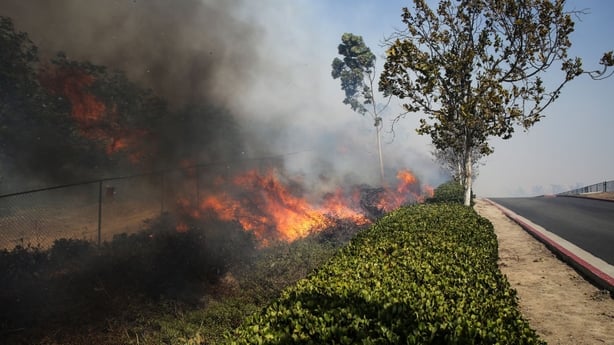More than 90,000 people have fled their homes near Los Angeles as two fast-spreading and uncontained wildfires rage across more than 5,900 hectares (14,600 acres), blocking key roadways and critically injuring two firefighters.
The larger Silverado Fire began in the foothills of Irvine, about 60km southeast of Los Angeles, and quickly spread, fuelled by dry conditions and erratic winds that prevented firefighting aircraft from flying.
"Firefighters continue to battle flames throughout the night on the Silverado Fire. More than 8,000 acres have burned but we have no reports of structures lost at this time," Orange County Fire Authority said in a Facebook update.
A second fast-growing blaze in Yorba Linda, about 30km north of Irvine and dubbed the Blue Ridge Fire, has already scorched more than 6,600 acres, also forcing evacuations.
"It's nuts - even inside the car, my eyes, my nose and my throat stung," said Frederic Tournadre, a French man whose company in Irvine sent all its employees home.
The Silverado inferno has quadrupled in size, jumping a highway and covering the area with a huge plume of smoke and ash.
"We have emergency evacuation orders here in the city of Irvine that are impacting approximately 90,800 residents," Shane Sherwood, a division chief at Orange County Fire Authority, told reporters.
The National Weather Service (NWS) warned that the combination of low humidity, dry vegetation and strong winds had created "the most dangerous fire weather conditions" this year.
It said the region will remain under a red flag warning - signifying a high risk of wildfire - until tonight.
"New fire ignitions in Los Angeles and Ventura counties will likely have very rapid fire growth, extreme fire behaviour, and long range spotting, resulting in a significant threat to life and property," the NWS said.

Officials said the two injured firefighters sustained second and third-degree burns and both had to be intubated at an area hospital.
"I got an opportunity to talk to members of their families and spend time with both firefighters in the emergency room while they were being treated, but they were not in a position where they could speak with me," Orange County Fire Authority chief Brian Fennesy told reporters.
He added that winds of 32-64km/h, with gusts up to 97km, had made it extremely difficult for the 500 firefighters trying to control the flames.
"Any time winds are that bad you can't fly, and that certainly has an impact on both hand crews and bulldozers and firefighters at the end of those hose lines," Mr Fennesy said.

The Silverado and Blue Ridge fires were burning as California and much of the US west are under major fire risk because of dry conditions and strong seasonal winds.
More than four million acres have been devoured this season by flames in California alone, where 31 people have died in some of the largest fires in the state's history.
Evacuations have been complicated by the coronavirus pandemic which has hit the state hard and hampered the work of firefighters.
The state fire agency Cal Fire said that more than 4,000 firefighters are battling 22 wildfires, with 34 million people under red flag warnings.
It said that wind gusts upwards of 130km an hour were expected in mountain areas of Los Angeles and Ventura counties.
The critical fire weather prompted Southern California Edison to shut off power to hundreds of customers in the two counties in a precautionary move to avert any electrical equipment from sparking blazes.
State officials have pointed to climate change as a significant cause of the wildfire surge.
Climate change amplifies droughts which dry out regions, creating ideal conditions for wildfires to spread out-of-control and inflict unprecedented material and environmental damage.

